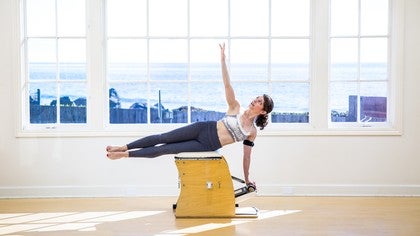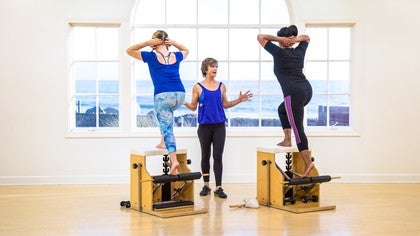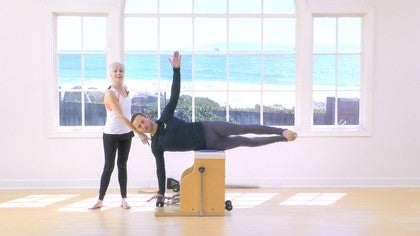Description
About This Video
Transcript
Read Full Transcript
Hello, I'm Rebekah Rothstein, and I'm thrilled to be back at Pilates Anytime. This is my eighth visit, and I realized that I have never filmed a wunda chair class. So I decided it's time to start. We're gonna do a workout on a wunda chair that incorporates couple spiral patterns, but also brings in some interesting balance challenges. So I'm using the Gratz chair, and I will try to tell you which settings I'm using, but I want you to keep in mind that I weigh less than a hundred pounds (laughs).
So, what my body does might be a little bit different than the average person, but I'll try and give you some cues as to what I'm doing. So we will begin with the hamstring one. And I have it set on one high, on the Gratz here. Let's begin lifting our arms up overhead. Reach your hands up for the sky.
Lift your toenails, and now, lower them down, maintaining those arches, and we're gonna start to dive forward, curling downward (exhales). I think almost of a geyser, going up to go down, and trying to maintain a bit of evenness of the curve through the spine. And then, I shift the weight forward just a little bit, so I get a lot more stretch through the low back. And then I come up just a bit, and I'm basically just gonna massage that low back area (exhales). And exhale again.
So I'm pulling up while I'm pushing down (exhales). And each time, I get a little bit more motion, a little bit more stretch in my back. And then I'm gonna go all the way down. Now I'm gonna shift my weight forward just a little bit, and notice how that changes the activation. And then I'm gonna start to lift up without shifting my weight back, and pushing down, and I'm really feeling my belly turn on now.
(inhales and exhales) And one more, and pushing all the way down. Now I'm going to bend one knee, and take the opposite arm up toward the ceiling to get a little rotational stretch (inhales). Inhale, and lower back down. Let's try the other side. Bend the other knee, and rotate and spiral, inhale (inhales).
And exhale (exhales), all the way back down. Now find that low back curve again (exhales), and flatten the back, starting to rise, and exhale, curve (exhales). Inhale, start to rise. Once more, exhale, curve (exhales). Now let's take a lunge.
Step back, and get a nice hip stretch, and return. And other leg back (exhales), and return. Once more, inhale (inhales). Exhale (exhales). And last time, inhale (inhales), and exhale (exhales).
And then we're gonna straighten the knees. Now notice how I could have my weight back, or we could shift the weight forward and maximize that curve in the low back. So for me, this is where my challenge is. I have a lot of tightness in flexion in my low back. Way too much extension, not surprisingly.
And coming all the way up (inhales). All right, let's go on to the next exercise. Let's do a little side stretch. So we're gonna sit facing the side of the chair. Now, I like to make sure that the toes of this free foot are facing directly forward, so that it becomes a real strong activation here, in the glute.
Opening the arms out to the sides, breathe in (inhales), and tip over (exhales)...exhale. Push over, and we're gonna get a nice stretch for the fascia on the lateral line, on the side. Now I'm gonna make this even more intense by pushing through my toes, go into a little relevè, and exhale (exhales). And return, and exhale. So it's like I'm flossing through the tissue (inhales).
And exhale (exhales). And this time I'm gonna stay, and go a little bit further, and pulse. One (inhales and exhales), two (inhales), and three (exhales). And coming all the way up. And grabbing the side of the chair.
We're gonna allow for a little bit of lateral flexion, going up, and down. Up, and down. Up, and down. Now straighten that knee, and lean away, and let your head tip away, and get a nice stretch through the scalene and through the lamina of the neck here. And coming up, let's try the other side.
Ooh, that side feels really good (laughs). Shock. So now I'm sitting on the other side. Again, toes face forward, so I'm very square and parallel here in my hips. I open my arms out to the sides, and I tip over.
And I push. And I should mention that I tend to like, by the way, I like to have the foot almost slightly behind the hip. So it's almost a tiny bit of hip extension. And, again, pushing over, I now relevè to reach the pedal. Now, granted, it might just be me and my shortness (laughs) that requires that relevè, but, it's an option.
And return. And coming back up, and let's repeat that. Tip over, and reach even more (exhales), and then return, and let's do one more push, and tip, and hold it here. Breathe in (inhales), and now stay in that relevè with the foot, and push over. One...and two...and three.
Keep going for length, so that you don't crunch through your side, but rather, thinking about the length through the stretching side. And once more. So I'm really pushing through the heel as well here, coming all the way up, and grabbing the side of the seat. And then, I let the hip drop, and lift. Drop, and lift.
I'm also thinking about my front knee, so that it points directly forward. Two more. And one. So we get a nice little bit of lateral lumbar flexion. And then, I'm going to let my head tip over, and come back up.
So I've just switched now, to one low and one medium spring. 'cause we're gonna do some footwork. We are going to start our footwork in a first position. And, just a little traditional style, pressing the hands into the seat, pushing down. And, to be honest, I don't really care how you breathe.
I just want you to breathe. My focus is more on the connection of the posterior shoulder girdle, and that length, pushing down to rise up. Let's do three more. Two, three. Now let's add in a little bit of freedom, so that we can liberate the body a little bit.
Let's do some arm swings. So swing (exhales). Growing taller each time (exhales). Other side (exhales). Now, I admit, this is inspired a little bit by Gyrotonic.
I'm not trying to mimic their breathing style, I just like the freedom of that experience. And returning. We're gonna add in a nice little bit of feedback now, taking the bar. So you can take just your typical bar that you use with the reformer. You can also, if you have a chair that has the pulls, I like to use those, because they're even heavier.
So, we're going to go into a parallel position now. Place the bar underneath the thighs. So, depending on your arm length, this might vary a little bit, but you're going to go and push as much as you can, 'til you basically are stopped, because your thighs hit the bar. And now we're keeping the feet close together, and we're gonna do some ankle work. One, two, three, four, five, six, seven, eight.
So you notice it's the ankles moving. Then, we bring the hands up overhead. This might be one of my very favorites, because it really gets those lower traps. Now, going onto the heels, you might notice that my right scapula's a little bit funny (laughs). So it might be good evidence for everybody of the things that we each work on ourselves.
So we're doing parallel pushing. One, two, three, four, five, six, seven, eight. Let's do two more. Nine...ten. Now let's add in a little bit more freedom and functionality.
Let's do kayaking. One...two...three...four. So you notice I come up and down, up and down, up and down. And I'm letting my elbows be soft. So it's not this, because this becomes very rigid, but it's free.
No, you're not locking the joint here, you're just allowing it to move. And then, finally, we're gonna do a little skiing. So, our knees are both gonna go to the same direction, and our hands will go slightly away. And the bar stays parallel. One, two, three, four, five, six, seven, eight.
And, lowering that bar down by your side. We'll do some hip lifts and bridges. So I'm gonna stay on my heels, place my hands behind me, lift my hips up, and pray (laughs). And push. One...two...three...four.
Squeezing, and lifting the hips. You know, I'm changing a little bit of my tune these days, on what I talk about of effort and squeezing. I think, in many ways, I didn't use to push myself enough. In other ways, I was pushing myself too much. So you might hear me say some things that I didn't used to say.
And that's all part of our own evolution in teaching. Enough, right? And now, single leg. One. It's interesting, if I keep talking, it makes it go faster (laughs).
Instead of focusing on the counts. And then, switch legs. And one...two. So I'm still focusing on lifting my hips up. And then just one more.
Oh, my gosh. Okay, let's do a stargazer. So pushing down through the heels, reach your hand toward the back of the seat, and lift up. And lower down. Other side.
Reach the back of the seat. And find that stretch through the front of the hips. And (laughs) we're all the way back down. We will next go into our stomach massage. So we lift our pants (laughs), then we reposition our feet into a Pilates first position.
And, we're gonna find this tuck that is going to be a recurring theme. So we're gonna rotate. Or actually, I shouldn't say rotate, but rather, transfer the weight from the sit bones actually back, so we're really on the coccyx at this point. Now we curl forward just a little bit, but notice the difference. It's not a crunch.
It's a lift and over, as we push. One, two, three, four, five, six, seven, eight. And, coming back up. And now, an attitude leg. And one, two, three, four, five, six, seven, eight.
Switching feet. And again. So, I'm finding that length as I push down, even though I'm curving, I'm not crunching. So be sure that you're finding that lift and length, so that you create space between the pelvis and the bra line, or the shoulder blade area. And last one.
And now we'll move into our swan. So we're gonna move into our swan, and I've changed the spring now, to one high. So we're gonna come and get a little bit of back extension, and back line work. So I like to have the shoulders directly over the wrists, reaching out through the toes, and working in the swan so that the extension's really focused and concentrated in the thoracic spine. Now it's okay for it to go a little bit lower, but I don't want you to sink.
So we go again, inhale (inhales). And exhale (exhales). Inhale (inhales). And exhale (exhales). Once more, inhale.
Finding the lift through the low belly to help you out, and lowering back down. Now let's undulate it. Flex the feet. Point the feet again. Inhale, rise up, and undulate (exhales).
So I'm so inspired by the dolphins outside that are doing this (inhales), and so I'm trying to imitate them (exhales), thinking of that movement of rising up (inhales), and (exhales) jumping down. Or, I guess I should say jumping up, to arc (exhales) up and down. Now let's add onto this with a little spiral. So we're going to open one thumb to the side and the opposite arm up. And lowering back down.
Other side. Leading from the thumb, and not coming very high. So we get a little cross-patterning here. Right hand, left leg. Finding the extension through the hip.
Inhale (inhales). And exhale once more (exhales). Keeping the knee straight. Keeping the elbows straight (exhales). And last time.
So we get a little bit of rotation with that spiral as well. Let's make it even more interesting. Let's maybe shift the weight just slightly forward, but let's lower down just a little bit. So we're gonna go into a tricep. And lift the heels.
And push. One, two, three, four, five, six, seven, eight. Now, feel like you're coming into a seesaw, rising up, and lowering back down. So we allow the knees to bend. Excuse me, these are the elbows.
We allow (laughs) the elbows to bend as the feet rise up. And one, two, three, four, five, six, seven, eight. And lengthening to come up. And lowering back down. Now let's bend the knees, and let's experience just a little bit of the seahorse, where we allow some rotation to occur, through the hips, that then transfers through the spine.
And down. And you'll notice that, inherently, you tend to wanna look toward the direction of those feet. And just one more. And lengthen legs out, flex the feet, push yourself away, and see if you could possibly go into what would be like the washer woman. Coming back up (gasps and laughs).
Now let's transition directly into the horseback. So, see if you could lift one foot, and then the other foot, walk your hands forward, swing your legs forward a little bit more, and reach your hands for the pedal. And push. Now, just like we were talking about before, don't do anything you can to push. This is not the picture that I want you to capture.
What I do want you to capture is that reach of the tail downward, where the back of the bra line, or the bottom of the shoulder blades, stay fixed, and the tail moves away from it (exhales). One (exhales), two (exhales), three (exhales), four (exhales), five. Now let the knees bend, and get a little, a little cow? I always confuse cat/cow. Here's the cow.
Here's the cat, or the horse. There's so many animals! Oh gosh (laughs). And inhale (inhales). Exhale (exhales). Inhale (inhales).
Exhale (exhales). And now, what if you allowed the spiral to happen? Again (exhales). What does this remind you of? Anybody see Saw?
(exhales) And allow yourself to roll back up from the tail, standing up. Now we're gonna move and change into a different position, preparing for the hamstring three. For myself, I don't need to add in another spring. The average person probably will. I'm just giving you that as a little precursor.
So let's begin with a prayer stretch, placing the elbows down here on the box. Or, this isn't a box. This is the seat. And allowing your head to drop. Now, if you're taller than me, which is most people, you're probably going to have to bend your knees even more than I am.
But I bring my hands into the prayer stretch. I like to keep the elbows fairly close together, so that I get a very good stretch of the fascial line that is around the teres major as well as the lateral head of the tricep. So I'm going to lift up just a little bit here, and stretch And lift. And stretch. And lift.
And breathe in (inhales). Hold it, exhale (exhales). Inhale (inhales). Keep pushing down through those elbows. Exhale (exhales).
Last time, inhale (inhales). Exhale (exhales). And that should help open up the arms for some of the other exercises we're gonna be doing. Next, let's go into a plank. And we're gonna do, basically an upside-down shape version of the hundred.
We're coming here, and in fact, we can go directly. Well, no, we'll stay right here. With our forearms down. And we're gonna go into our plank, but we're gonna push ourselves even further back. And we're gonna hold this, so that we're in a little curve, just like we would be in the hundred.
Can anybody see how this shape, hopefully, I don't know what I look like, but hopefully it matches? Holding it, one, two, three, four, five. Now pushing into those forearms. So you're pushing the forearms away while you're pushing into the feet. And you're getting what some would call the two-way stretch, right?
Five, six, seven, I'm a terrible counter. Eight, nine, ten. Now lift up even a little bit more through the upper back, keeping the roundness there. And relax. So you're getting that nice little isometric hold which is gonna prepare us for the hamstring three that we're about to do right now.
Okay, so we step down, placing one hand on either side of the chair. And actually, try this first. Place your hands on top of the chair, and just shift your weight forward. This is something that I do with an 84-year-old client of mine, and it's really, really effective for motor control. So, granted, the Gratz chair's a little bit more cushiony than I would use with her, but the idea is to get her to push into her hands and feel that direct connection into her trunk.
Now, granted, I'm having her do it with a more flat back. Right now, we're doing it here. Let's try it with a rounded back, just so you can feel that connection. Now place your hands onto the side, and let's prepare ourselves for the hamstring three. And let's do it in a Pilates first position.
We're gonna lift our heels, find that tuck of the tail that we were working on previously, and now we're gonna experience the rounded-ness that we just did in that held, sustained plank, that upside-down hundred, as we just shift our weight forward. Hover. And lower. And again, hover. And lower.
And hover, a little bit higher, higher. I have to reposition my feet. Higher, higher, higher, higher, higher. There's that tail connection. And lowering yourself down.
And again, up (exhales). How high could you go? Oh-uh! And down. And again. Ignore my right shoulder blade.
Or actually, maybe look at my right shoulder blade, 'cause you'll see how it's not connected. 'cause I can feel it right now. And once more (exhales). Now let's stay up, keep the knees bent, and now swivel. Push, push, push.
So I'm swiveling my knees side to side. Five, four, three, two, one. Whew! And take a step off, quietly releasing the chair. So I'm gonna walk over here to do some teaser, because my belly hasn't had enough of a workout yet. Now, teaser is one of the hardest things for me, so you're gonna see a little variation that I do.
So I like to begin, now, granted, I can fit on here, but I like to begin with my butt a little bit further away, and then I reach my hands for the pedal, and I allow that movement of the tailbone I was talking about before. So remember we were saying before how to find that stretch of the low back by moving the pelvis. So I've been cueing the tailbone, but essentially, it's a posterior tilt, right? So I'm gonna posteriorly tilt my pelvis here (exhales), and hold it. Breathe in (inhales).
Exhale (exhales). Push a little bit further. Notice where the push is coming from. Sure, there's a little bit of extension from the arms and the shoulder, but it's really because I'm moving more from my pelvis, as opposed to leaning back. So we go one (exhales), two (exhales), three.
Now, reach the feet up (exhales). Four (exhales), five (exhales). So notice, again, it's happening through the spine. The spine is not lifting up, the spine is lengthening downward. Now pause.
Lower one foot. And up. Lower the other foot. And up. If you can, lower both feet.
I can't. And push two more. One, two. Hold it, and slowly, slowly return back up. Feeling that very, very deep connection.
Now try and lift your arms up. Maintain that deep connection, place your hands forward. Maintain that deep connection until you can push yourself up. And rise up. All right.
Now we're gonna go into some side sit-up work. So I'm still on one high, and I'm going to press down on the pedal. So again, my shoulder's just about over my wrist. And I lift my arm up toward the ceiling. And I lift up.
One. Reaching out through my toes. Two, three. So I'm finding the length, so that I arc up. Three, four, five.
Now we're gonna add in some balance challenge. Reaching down, swiveling from the thumb, and lifting up. Two. And lengthening, lengthening, lengthening. And you'll notice that the eye movement, the gaze stabilization, becomes even more challenging.
Three. And four. Now let's add in something different with the legs. The bottom leg goes forward, the top leg goes back. And we're gonna reach down.
Continue that with the arm, but as the arm comes up, we swivel, lifting that top leg, so it's now in external rotation. So we bring in a little P-and-F pattern, and we point the toes here (exhales). And we swivel, flexing the feet. And let's do two more. Point the toes, swivel (exhales).
Flex (laughs). And last one. Point (exhales). And flex, coming up. Now this time we're gonna go back down and stay here, repositioning the hand, so we get a nice stretch, reaching through this top foot here, and through the same side arm.
Lengthening, lengthening, lengthening, and coming up just a little bit, and down (exhales). And up, and down. This time, bend that back foot. That didn't make sense. Bend the back knee, and look toward it.
And flex, and rise, and bend. And flex, last time. Rise and bend. And flex. Reposition the left hand.
And now, bring your feet together. Get a nice side stretch here. And rise up. Let's try the other side. So we go onto the right side now.
We reach down to the pedal, lengthening, and pushing in all directions, so through the head, through the feet, through both arms, so that we rise up, and lowering back down. And up. And down. Let's do two more. Up.
Keep lengthening, finding the stretch in all directions. Up. And all the way down. Let's add the arm swivel. So on the way down, we'll swivel through the hand.
And then let it rise up. And down (exhales). And rise up (inhales). And down (exhales). And up, last time.
Down (exhales). And up. Now, bring that top foot back, and swivel to push (exhales). Now, on the way back up, we flex the feet, and the top leg comes up, and the thumb leads the way as you go down. And the thumb leads the way to come up.
So again, I'm externally rotated and flexed in this top hip, bringing you into a nice little P-and-F pattern (exhales). And back up. One more after this. And down. So it almost reminds you a little bit of teaser, but it's not quite teaser.
And back up. Last one. Stay. Reach your hands both on the pedal, and push down (exhales). One (inhales and exhales), two (inhales), three, stay.
Bend the back knee, look at it, and flex, and point. And flex, and point. And flex, I call this the fishtail. And point. And actually, I forgot to tell you, sorry, reposition the right hand, so that we can restack our hips.
Little side bend, and come all the way up. Whew! Let's continue on now. So let's do a little one-arm push, sort of like a side push-up. So we're gonna take a forearm on the seat and a hand on the pedal, and bring ourselves into a plank, and push down. One, two.
So we swivel here, through the trunk. Three, four. Now, no swiveling, just tricep. One, two, three, four. Now, keeping this elbow straight, sidestep.
One, two, three, four. Now swivel, side, reach, side. So I turn my hips to the direction of the moving foot. Keep going. So you make it a little dance, but you're gonna feel it in the belly, the entire waistline.
Let's try that on the other side. You'll have a better view over here as well. Not that I'm saying you're gonna have a better view of my butt (laughs), but of the exercise. So we take the forearm onto the seat, the hand onto the pedal, bring ourselves into a plank position, and first it's this swivel through the trunk. And you know what?
Now that I think about it, I'm probably swiveling through my hips as well. Now no swivel, tricep. One, two, three, four. Sidestep. One, two.
Actually two (laughs). And three. And four. Now swivel-step. See how I'm doing that?
So I swivel and I step. Swivel, step. Swivel, step. Swivel, step. Swivel, step.
Swivel, step. And relax. It's time to end with some work for the lower body. So I've made a spring change, putting on one low and one medium. We're gonna do climb a mountain, which, again, depending on the size of yourself, or of the client, depends on what kind of spring tension you might want.
So I'm gonna step down on the pedal. And actually, I'm gonna start on this one. Support myself up here. And, because my ankles tend to pronate, I like to establish my arch of the foot first, to make sure that it's not collapsing inwards as I do this. So now that I've got that set up, I'm gonna bring myself into my lift, and lower.
Lift, lower. Lift, lower. Lift, lower. Now we're gonna add in some gait patterning. And, let's see, we're gonna go up.
And I'm gonna add in a head movement as well. Looking. And looking. So, what's the pattern? That as I come up, the opposite arm and leg are in front.
And don't crash like I just did. And last time. Then I'm gonna switch the other side. This might be a little harder for me. We're gonna find out.
So I'm gonna start to come up, but first, again, I have to establish that connection into my foot. Yep, see there's my wobbliness. And I'm gonna come up. Actually, my foot's not far enough away. There we go.
So I come up, very slowly, because each time, progressively, a little bit more, I feel the connection into my hip, and then I feel more stable as a result. And lowering down. And I'm gonna add in the arm swing. One, two. Now I feel connected.
And now I can turn my head. So notice how we layer it in sequence, adding in a little bit more challenge each time. And last time. And can take a foot off, and allow that pedal to rise. This deserves a little bit of candy.
So, for me, the candy is allowing myself to get a back bend. Now, I tried this, actually, on some other people. Usually, it works, but, somebody who is quite tall, it might not be the best exercise for you. So, we're gonna lower ourselves down, and scoot back to the point where you can touch your hands to the pedal. Now I'm gonna lift my heels, and I'm pushing the pedal away.
This is an amazing preparation for back bends, because it builds the strength with length that is required for that shoulder extension to occur. Excuse me, for the shoulder flexion to occur. And I get that length with connection, so that I get the necessary inferior glide, or drop of the humerus into the socket. And then hold it. One, two, three, four, five Keep reaching, reaching, reaching.
And slowly allowing yourself to come back up. So that's our back bend candy. We're gonna have one hard exercise to finish off with, which is our push-ups. All right, ready? We're gonna take our arms up, and we're gonna lower ourselves down, finding the curve through that low back as well, and stepping out so that you're just at the point where you're in, almost like a down dog here.
Breathing in, and let's just push the pedal down a little bit. One (exhales), two (exhales), three. Now let's walk the hands out a bit more. Mmmm, I'd say about right here. And then we're gonna push the pedal down again.
One (exhales), two (exhales), three. Now I'm gonna step back just a little bit, you can pause for a moment, and try once again. Push one (exhales), two (exhales), three. Pull the arms back even a little bit more (exhales). One (exhales), two (exhales), three.
And now walk all the way up, and see if you could lift the foot up toward the ceiling. If you wanted, you could actually come all the way up, but we won't (laughs). And try the other. And lowering the foot to the bar. Bend your knees here.
Breathe in, push back, inhale, exhale, step off, shake out your hands. We're gonna end with a calf stretch. I'm really tired (laughs). All right, push down on the pedal, and you're gonna step back with one foot. So basically, one heel will hang off the bar, off the pedal.
Hopefully I can get my terminology right (laughs). Inhaling and exhaling (exhales), just thinking about all the work that we've done. In all these years, I think this might be the hardest workout that I've given myself on Pilates Anytime, I don't know. Trying the other side. So allow yourself to feel that connection though, in all seriousness, experiencing how the heel really lengthens away from the crown of the head.
Now we're gonna add in a little balance challenge. So go to the first side again, and we're gonna lift both heels, and lower. Lifting, and lowering. If you want, stay up, turn the head. Try the other foot.
So you're going from the calf stretch into a bit more change for some motor control. Lifting up. And you may have noticed that I just felt my connection here, and that changed all of the structure above. And down, and last one. And off.
So I'm going to quickly, or slowly, not so slowly, let the pedal rise. And let's just end standing, lifting the arms all the way up once more like we did (inhales). And lowering down. Thank you so much for joining me.
Wunda Chair Workouts: Advanced Wunda Chair Classes
Comments
I have particularly tight thoracic spine and I felt amazing afterwards!
I speak little english and I can not express myself well, but in summary, I found it incredible. Tomorrow, I start to practice it. Thank you very much from Madrid, Spain.
You need to be a subscriber to post a comment.
Please Log In or Create an Account to start your free trial.





































